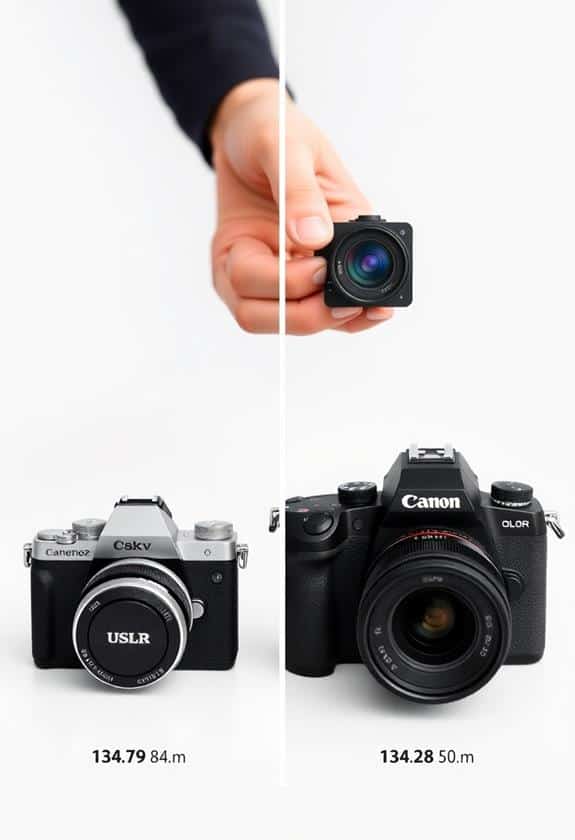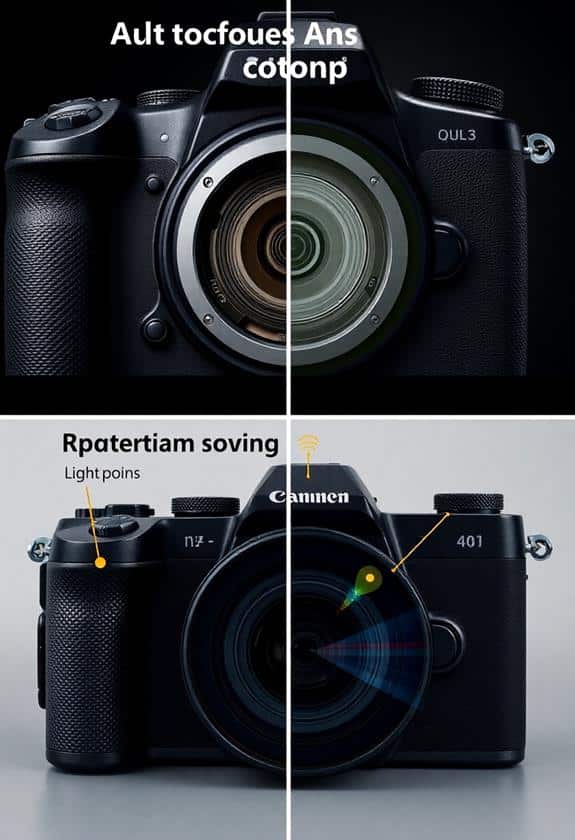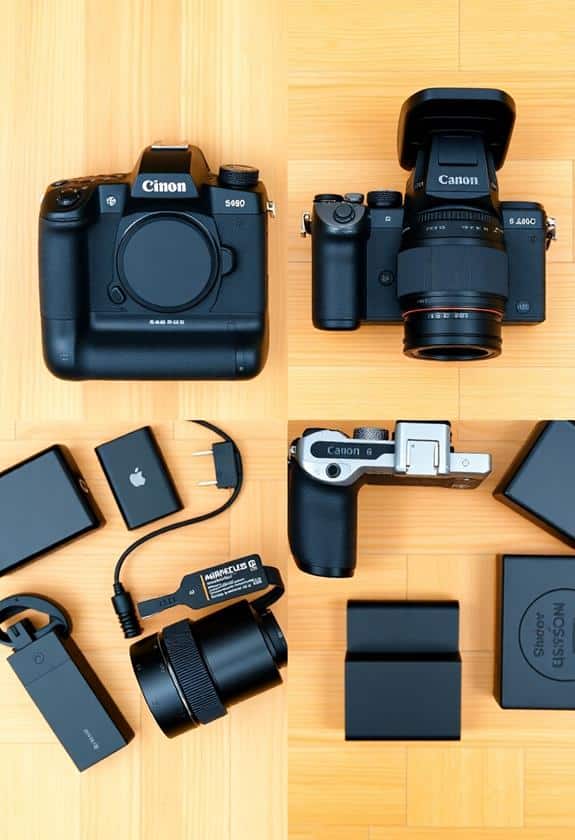When you’re choosing between a DSLR and a mirrorless camera, remember these key differences! First, size and weight matter—mirrorless cameras are usually lighter and smaller, making them perfect for those spontaneous adventures. Imagine not having to lug around a heavy camera! Second, autofocus technology varies. Mirrorless cameras use faster, more efficient autofocus, so you won’t miss those quick moments, like your friend’s goofy dance. Finally, battery life—DSLRs usually have longer battery life thanks to their optical viewfinders. So, pack some extras if you go mirrorless! Stick around, and you’ll discover even more tips to make your camera choice easier!
Key Highlights
- Mirrorless cameras are smaller and lighter than DSLRs, enhancing portability and reducing fatigue during extended use.
- DSLRs typically utilize phase-detection autofocus, while mirrorless cameras combine contrast and phase-detection for faster and more accurate focusing.
- Battery life tends to be longer in DSLRs, as they use optical viewfinders, whereas mirrorless cameras drain batteries more quickly with electronic viewfinders.
- Mirrorless cameras often feature superior video capabilities and live view options compared to traditional DSLRs.
- Lens options may vary significantly, with DSLRs having more extensive selections, while mirrorless systems are expanding rapidly.
Size and Weight

When it comes to size and weight, mirrorless cameras often have the upper hand. You’ll notice that they’re typically smaller and lighter than their DSLR counterparts, which makes them an attractive option for many photographers. This is particularly true when considering top mirrorless cameras that combine portability with excellent performance. This can be a game-changer, especially if you’re planning on carrying your gear around for long periods. I remember hiking up a hill to catch the sunset, and my DSLR felt like a weighty anchor, while my friend’s mirrorless camera felt like a feather.
With a lighter camera, you’ll feel less fatigue, which means you can focus on capturing those stunning shots without worrying about shoulder strain. Plus, if safety is on your mind, a smaller camera is easier to conceal, making it less likely to attract unwanted attention.
You might also find that mirrorless lenses are often more compact, so you can travel light without sacrificing quality. When you’re out filming or photographing, every ounce counts! So, if you’re considering a camera, think about how size and weight can impact your creativity and enjoyment. After all, you want to have fun, not feel like a pack mule!
Autofocus Technology

Autofocus technology plays a significant role in the overall performance of cameras, especially when you’re capturing fleeting moments. If you’ve ever tried to snap a picture of a jumping dog or a racing friend, you know how vital quick and accurate focus can be. DSLRs typically use phase-detection autofocus, which is like a trusty old friend—reliable but a bit slow in low light. On the other hand, mirrorless cameras use contrast-detection and phase-detection combined, meaning they can often lock onto a subject faster and more accurately, especially in tricky lighting situations. This is particularly beneficial when filming with essential cameras for aspiring filmmakers, as they often emphasize the importance of autofocus performance.
I remember a time when I tried to film my younger sibling’s soccer game. The DSLR struggled to keep up with the action, while my friend’s mirrorless camera effortlessly tracked the ball. It was a game-changer! So, if you want to capture those spontaneous moments, consider how each camera’s autofocus system fits your needs.
Ultimately, whether you choose a DSLR or a mirrorless camera, understanding their autofocus capabilities can make all the difference. You’ll be better equipped to capture those magical moments without a hitch, ensuring your memories are safe and sound!
Battery Life

In the world of photography, battery life can make or break your shooting experience. Imagine you’re out on a beautiful hike, camera in hand, when suddenly your battery dies right before capturing that perfect sunset. Frustrating, right? This is where the differences between DSLRs and mirrorless cameras really shine.
Generally, DSLRs have a longer battery life because they use optical viewfinders that don’t consume much power. You can often shoot hundreds of pictures on a single charge. Additionally, discover the best DSLR options to guarantee you have a reliable camera for long shoots. On the other hand, mirrorless cameras usually rely on electronic viewfinders, which can drain the battery faster. You might only get a few hundred shots before needing a recharge.
To avoid those heart-stopping moments, it’s smart to carry extra batteries, especially if you plan to shoot all day. Investing in a battery grip for your camera can also extend your shooting time, giving you peace of mind. Plus, don’t forget to keep your batteries warm in colder weather; cold can zap their power surprisingly fast.
Frequently Asked Questions
Which Camera Type Offers Better Video Recording Capabilities?
When it comes to video recording, you’ll find that mirrorless cameras often shine brighter. They usually offer faster autofocus and superior video quality, which makes capturing those epic moments way easier. I remember struggling with my old DSLR during a school project, missing vital shots because of slow focus. Switching to a mirrorless model transformed my filmmaking. So, if you’re serious about video, consider giving mirrorless a shot—they might just make your life a whole lot easier!
How Does Lens Compatibility Vary Between DSLRs and Mirrorless Cameras?
Imagine you’re at a park, ready to capture your friend’s epic skateboard tricks. When it comes to lens compatibility, DSLRs usually have a wider range of lenses available since they’ve been around longer. On the other hand, mirrorless cameras are catching up quickly. You might find an adapter for older lenses, but it can be tricky. So, think about your photo goals and choose wisely—your creativity deserves the best tools!
What Is the Average Lifespan of Each Camera Type?
You’ll find that the average lifespan of cameras can really depend on how you use them. Typically, DSLRs last about 5 to 10 years, while mirrorless cameras might go for around 5 to 7 years. I once had a DSLR that survived countless adventures, but I took good care of it. If you’re passionate about filming, remember to clean your gear regularly and store it safely to extend its life!
Are There Significant Differences in Image Quality Between the Two?
You know, it’s fascinating that most photographers can’t tell the difference in image quality between DSLR and mirrorless cameras! Both types produce stunning images, but the real magic often lies in how you use them. With good lighting and composition, you can create fantastic shots regardless of the camera. Just remember, practice makes perfect! So, don’t stress too much—focus on capturing those moments that matter, and have fun while you’re at it!
Which Type Is Better for Beginner Photographers?
When you’re starting out in photography, a mirrorless camera might be the better choice for you. They’re usually lighter and more compact, making them easier to carry around. Plus, their real-time previews help you see how adjustments affect your shot, which is super handy! I remember feeling overwhelmed with my first camera, so having something user-friendly can really boost your confidence. Just have fun and experiment with different settings; you’ll learn quickly!
Conclusion
So, whether you’re drawn to the compact charm of a mirrorless camera or the sturdy feel of a DSLR, remember that each has its quirks and perks. I’ve wrestled with both types, sometimes missing that perfect shot because of a heavy camera bag! But capturing those fleeting moments makes it all worth it. Choose what feels right in your hands, and don’t forget—every picture tells a story, so go out there and start yours!



